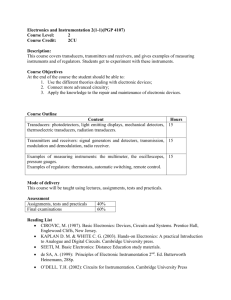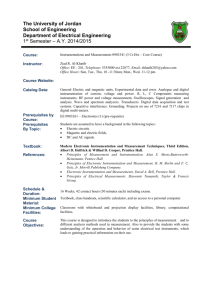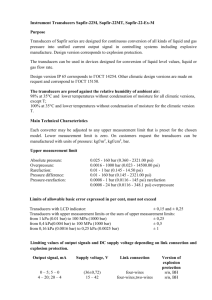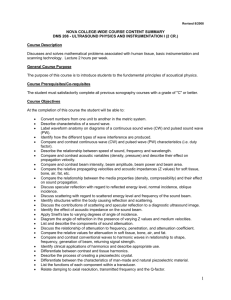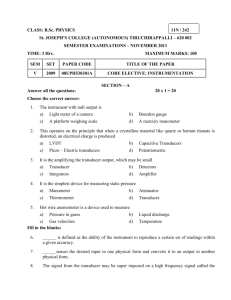classification of transducer
advertisement
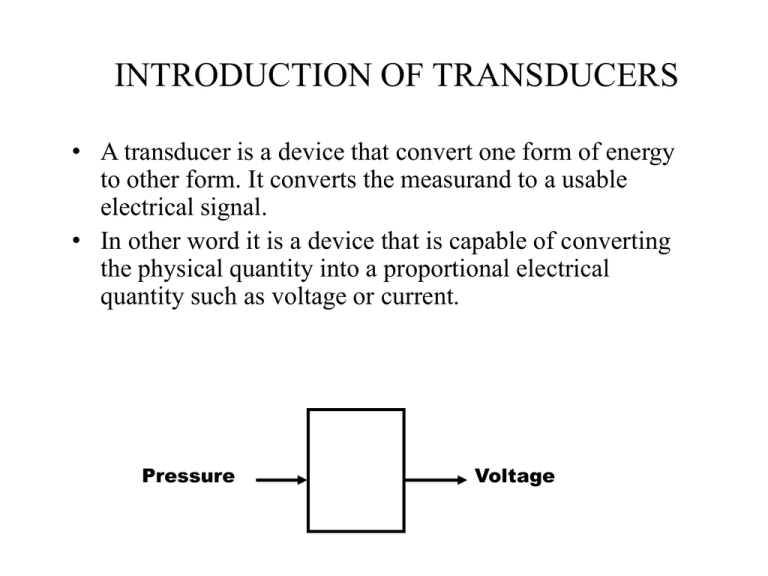
INTRODUCTION OF TRANSDUCERS • A transducer is a device that convert one form of energy to other form. It converts the measurand to a usable electrical signal. • In other word it is a device that is capable of converting the physical quantity into a proportional electrical quantity such as voltage or current. Pressure Voltage BLOCK DIAGRAM OF TRANSDUCERS • Transducer contains two parts that are closely related to each other i.e. the sensing element and transduction element. • The sensing element is called as the sensor. It is device producing measurable response to change in physical conditions. • The transduction element convert the sensor output to suitable electrical form. CHARACTERISTICS OF TRANSDUCERS 1. 2. 3. 4. 5. 6. 7. 8. Ruggedness Linearity Repeatability Accuracy High stability and reliability Speed of response Sensitivity Small size TRANSDUCERS SELECTION FACTORS 1. 2. 3. 4. 5. 6. Operating Principle: The transducer are many times selected on the basis of operating principle used by them. The operating principle used may be resistive, inductive, capacitive , optoelectronic, piezo electric etc. Sensitivity: The transducer must be sensitive enough to produce detectable output. Operating Range: The transducer should maintain the range requirement and have a good resolution over the entire range. Accuracy: High accuracy is assured. Cross sensitivity: It has to be taken into account when measuring mechanical quantities. There are situation where the actual quantity is being measured is in one plane and the transducer is subjected to variation in another plan. Errors: The transducer should maintain the expected inputoutput relationship as described by the transfer function so as to avoid errors. Contd. 7. Transient and frequency response : The transducer should meet the desired time domain specification like peak overshoot, rise time, setting time and small dynamic error. 8. Loading Effects: The transducer should have a high input impedance and low output impedance to avoid loading effects. 9. Environmental Compatibility: It should be assured that the transducer selected to work under specified environmental conditions maintains its input- output relationship and does not break down. 10. Insensitivity to unwanted signals: The transducer should be minimally sensitive to unwanted signals and highly sensitive to desired signals. CLASSIFICATION OF TRANSDUCERS The transducers can be classified as: I. II. III. IV. V. Active and passive transducers. Analog and digital transducers. On the basis of transduction principle used. Primary and secondary transducer Transducers and inverse transducers. ACTIVE AND PASSIVE TRANSDUCERS • Active transducers : • These transducers do not need any external source of power for their operation. Therefore they are also called as self generating type transducers. I. The active transducer are self generating devices which operate under the energy conversion principle. II. As the output of active transducers we get an equivalent electrical output signal e.g. temperature or strain to electric potential, without any external source of energy being used. Piezoelectric Transducer CLASSIFICATION OF ACTIVE TRANSDUCERS ACTIVE AND PASSIVE TRANSDUCERS • Passive Transducers : I. These transducers need external source of power for their operation. So they are not self generating type transducers. II. A DC power supply or an audio frequency generator is used as an external power source. III. These transducers produce the output signal in the form of variation in resistance, capacitance, inductance or some other electrical parameter in response to the quantity to be measured.


